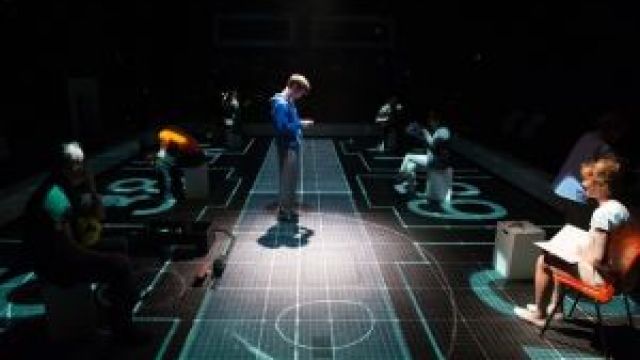The Curious Incident of the Dog in the Night-Time
As my colleague Coral Drouyn has already reviewed this production (and very enthusiastically too), I’ll raise another issue - and perhaps demur from Ms Drouyn’s approbation.
Having now seen a number of National Theatre Live presentations, it is pertinent to ask just how successful this form of presentation is since it is, after all, ‘filmed theatre’ and not ‘a film’. For those who have not seen a National Theatre Live presentation, they are, firstly, not exactly ‘live’ for all audiences across the world in the sense of being simultaneous with the show playing on one of the stages at the National Theatre, Southbank, in London.
You watch a superbly acted, beautifully lit and recorded performance and whether it’s really ‘live’ or not really doesn’t matter a damn; what you see, or would see (if it were really ‘live), is exactly the same.
As what is recorded is an actual performance (sometimes tricked up just a little), in an actual theatre, with a live audience (which we see – there is no attempt to hide them), there can be no stopping – as in a ‘live’ sports presentation, but in this case the camera directors can rehearse since they know exactly what they must ‘cover’.
We, the movie theatre audience, still get access to a National Theatre of Great Britain production, for which we can be grateful, but, unlike what the audience in the actual theatre gets, we get wide shots, two shots, medium shots and close ups. We even get crane shots and top shots from directly above. All the audience in the theatre gets is their own wide shot and its up to them and the blocking and focusing skills of the director whether what they see in front of them is a medium shot, a two shot or a close up. The live audience in the live theatre never gets a top shot, which we did with The Curious Incident – but more of that in a moment.
The point of this preamble is that not all these presentations work equally well and, indeed, it’s possible that this mode of presentation can actually work against the material of the play itself. I believe this is the case with The Curious Incident.
If we take a contrasting example, say, the National Theatre Live’s presentation of Racine’s tragedy Phaedra, the stylized set, the high-flown rhetoric and the distraction of Helen Mirren’s feet in high definition make us quite aware that this is ‘filmed theatre’ and we never quite engage enough to forget that. On the other hand, One Man, Two Gov’nors, a very fast moving, very physical, quite ridiculous farce on an undisguised proscenium arch stage paradoxically works a treat. Perhaps because it’s funny.
In the case of The Curious Incident of the Dog in the Night-Time, you spend most of the time wishing, even more than you usually do, that you were actually in the theatre, because there is no doubt that, objectively, this is a stunning production. The cast, many of whom play multiple roles, are without exception wonderful, particularly Luke Treadaway as our autistic teenage hero. Played in the round, with steeply raked seating, the show employs outstanding use of modern technology: the playing space lights up with paths like mazes; mathematical formulae and London Tube station names flow across it. Marianne Elliott’s direction, aided by her Movement Directors, Scott Graham and Steven Hoggett, is consistently inventive, sensitive, humorous and imposes a compelling rhythm. A large problem, however, is that the play’s rhythms and Ms Elliott’s rhythms are not the rhythms of the cutting between cameras of the ‘live coverage’. Watching in the movie theatre, we see things too that the theatre audience couldn’t possibly see. For just one example, a top shot that shows our hero apparently descending some stairs. In reality the ‘stairs’ are created by lighting and our hero is lying on his side and moving his legs as if he is descending. You can fall for this or not. In my case, not. In my case, it was, ‘Oh, I see how they’re doing that – hmm, quite clever…’
For me, since obviously I was not in the Cottesloe Theatre at the National, these effects and tricks were distancing. (I could say ‘alienating’, but we won’t go there.) Only the superb Nicola Walker as the hero’s mother, who has abandoned him, grabbed me by the throat. Overall, I just wasn’t drawn in and ended up with the same response as I had to the original novel. Once you get past the trick (gimmick?) of telling a story through the sensibility of an autistic boy, the story itself isn’t really that interesting. In fact, at the risk of seeming horribly insensitive, it’s pretty banal and in the second half becomes bogged down in rather dreary soap. It also seems to take a long time to state the bleeding obvious. But, clearly, this is just my reaction. I was surrounded by people undoubtedly enjoying themselves. The original production moved from a sell-out season at the National to the Apollo in the West End and received seven Olivier Awards, including Best New Play. It’s having another West End run and then moving to New York. Obviously, you had to be there.
Michael Brindley
Subscribe to our E-Newsletter, buy our latest print edition or find a Performing Arts book at Book Nook.

